Analysis of the Impact of Omitted Accidental Actions and the Method of Land Use on the Number of Construction Disasters (a Case Study of Poland)
Abstract
:1. Introduction
2. Materials and Methods
- technical and design, combined with analyzing applicable legal acts and standards,
- analytical with respect to the variability of the number of construction disasters on a multi-annual basis and their main causes,
- correlative between the number of construction disasters and the actual land-use conditions that may affect the likelihood of their occurrence.
2.1. Construction Disaster Definition
2.2. Accidental Actions
2.3. Design of Buildings and Construction Works for Accidental Actions
- Σ Gk is the combined effects of characteristic persistent actions,
- “+” means “that it should be considered in combination with…”,
- P is the prestressing action,
- Ad is the notional accidental action,
- Qk,1 is the characteristic leading transient action,
- Σ ψ2,i Qk,i is the combined effect of accompanying transient actions, and
- ψ1,1,ψ2,1 is the combination of factors for accidental design situations, depending on the accidental design situation (e.g., impact, fire, condition of a structure after an accidental event).
- −
- if the variability G can be considered as small, it is permissible to use one single value Gk,
- −
- if the variability G cannot be regarded as small, two values should be used: the higher value Gk,sup and the lower value Gk,inf.
- −
- the top value with the assumed probability of this not being exceeded, or the bottom value with the assumed probability this being achieved in the definite return period,
- −
- a nominal value that can be determined if the statistical distribution is unknown.
- Fk is the characteristic value for action,
- Frep is the appropriate representative value for action,
- γf is the partial factor for action, including the possibility of unfavorable deviations from representative values, and
- Ψ is the reducing coefficient.
- −
- factors γf including the uncertainty of the represented values of actions (γf) and the uncertainty of the model of actions and their effects (γSd),
- −
- factors γM including the uncertainty of the ULS model (γRd) and the uncertainty of material properties (γm).
- −
- Consequence class CC1—low consequences of failure (low risk to human life, minor social, economic, and environmental consequences), no specific consideration of accidental actions;
- −
- Consequence class CC2—medium consequences of failure (medium risk to human life, major social, economic, and environmental consequences), design is dependent on the specific circumstances of the structure in question: a simplified analysis is performed through the use of static equivalent load models for identified accidental loads and/or prescriptive design/detailing rules are applied;
- −
- Consequence class CC3—high consequences of failure (high risk to human life, significant social, economic, and environmental consequences), design considering accidental actions, previously preceded by determining the level of reliability and detailed design requirements as well as risk analysis [35,37].
3. Results
3.1. Construction Disasters in Poland between 1995–2018
3.2. Statistical Analysis of the Impact of Land Use on the Total Number of Disasters
- xi,yi are the data series values,
- are the average values,
- are the squares of the difference of ranks with corresponding values xi and yi, and
- n is the number of data pairs.
- Where the p-value is less than 0.05 we can say that there is a very strong evidence to believe H1,
- t statistic defined by formula [48]:
4. Discussion
5. Conclusions
- −
- the trend in the number of disasters is imperceptible. The number of construction disasters is greater than at the beginning of the data collection, nevertheless this may be due to a more efficient architectural and construction administration than the actual number of disasters (Figure 5),
- −
- the relationship between the location of a voivodeship in Poland and the number of construction disasters is imperceptible (Figure 6),
- −
- small-cubature residential, farm, and livestock buildings of masonry construction are the buildings most frequently subject to construction disasters (Figure 7),
- −
- a steady upward trend showing the predominance of construction disasters caused by random events over non-random events is noticeable (Figure 8),
- −
- on average, 70% of the analyzed construction disasters are caused by random events (Figure 9),
- −
- strong winds are the cause of the greatest number of construction disasters (more than 50%). In turn, fires can be listed as the second factor causing construction disasters. Other events such as a gas explosion or rainfall occur in similar numbers (Figure 10),
- −
- a steady upward trend in the number of people injured in construction disasters is noticeable,
- −
- half of the construction disasters concern masonry structures, followed by wooden, steel, and reinforced concrete buildings,
- −
- over 90% of the structures which were subject to construction disasters were objects which already existed, were used or excluded from use, and in which construction works were carried out,
- −
- for more than half of the buildings, the service life until the occurrence of a construction disaster ranged from 11 to 50 years, then from 51–100 years to over 100 years. The least number of construction disasters is recorded for buildings under 10 years old which on average made up approximately 5% of the total,
- −
- most of the buildings, more than 80%, that underwent construction disasters belonged to Polish citizens.
Author Contributions
Funding
Institutional Review Board Statement
Informed Consent Statement
Acknowledgments
Conflicts of Interest
References
- Hov, O.; Cubasch, U.; Fischer, E.; Höppe, P.; Iversen, T.; Kvamstø, N.G.; Kundzewicz, Z.W.; Rezacova, D.; Rios, D.; Santos, F.D. Trends in Extreme Weather Events in Europe; EASAC Policy Report 22; European Academies’ Science Advisory Council: Halle, Germany, 2013. [Google Scholar]
- Kron, W.; Löw, P.; Kundzewicz, Z. Changes in risk of extreme weather events in Europe. Environ. Sci. Policy 2019, 100, 74–83. [Google Scholar] [CrossRef]
- Żurański, J.A.; Gaczek, M.; Fiszer, S. Damaging Winds Action on Buildings in Poland. In Proceedings of the XXIV Scientific and Technical Conference “Awarie Budowlane”, Szczecin-Międzyzdroje, Poland, 26–29 May 2009. [Google Scholar]
- Ksit, B.; Szymczak-Graczyk, A. Rare weather phenomena and the work of large-format roof coverings. CEER 2019, 30, 123–133. [Google Scholar] [CrossRef] [Green Version]
- Yang, Q.; Gao, R.; Bai, F.; Li, T.; Tamura, Y. Damage to buildings and structures due to recent devastating wind hazards in East Asia. Nat. Hazards 2018, 92, 1321–1353. [Google Scholar] [CrossRef]
- Żurański, J.A. Failures of roofs under Snow loads in Poland. In Proceedings of the XXIII Scientific and Technical Conference “Awarie Budowlane”, Szczecin-Międzyzdroje, Poland, 23–26 May 2007. [Google Scholar]
- Szymczak-Graczyk, A. Icing effect on steel bar structures. Annu. Set Environ. Prot. 2018, 20, 934–947. [Google Scholar]
- Lucchi, E.; Pereira, L.D.; Andreotti, M.; Malaguti, R.; Cennamo, D.; Calzolari, M.; Frighi, V. Development of a Compatible, Low Cost and High Accurate Conservation Remote Sensing Technology for the Hygrothermal Assessment of Historic Walls. Electronics 2019, 8, 643. [Google Scholar] [CrossRef] [Green Version]
- Bathrellos, G.D.; Skilodimou, H.D.; Soukis, K.; Koskeridou, E. Temporal and Spatial Analysis of Flood Occurrences in the Drainage Basin of Pinios River (Thessaly, Central Greece). Land 2018, 7, 106. [Google Scholar] [CrossRef] [Green Version]
- Laks, I.; Kałuża, T.; Sojka, M.; Walczak, Z.; Wróżyński, R. Problems with modelling water distribution in open channels with hydraulic engineering structures. Annu. Set Environ. Prot. 2013, 15, 245–257. [Google Scholar]
- Laks, I.; Walczak, Z. Modelling of the impact of the retention reservoir on the flood protection of the city–A case study for the city of Kalisz (Central Poland). IOP Conf. Ser. Mater. Sci. Eng. 2019, 603, 022066. [Google Scholar] [CrossRef] [Green Version]
- Laks, I.; Walczak, Z.; Szymczak-Graczyk, A.; Ksit, B.; Mądrawski, J. Hydraulic and legal conditions for buildings in floodplains—A case study for the city of Kalisz (Poland). IOP Conf. Ser. Mater. Sci. Eng. 2019, 471, 102050. [Google Scholar] [CrossRef]
- Garcia-Ayllon, S. Long-Term GIS Analysis of Seaside Impacts Associated to Infrastructures and Urbanization and Spatial Correlation with Coastal Vulnerability in a Mediterranean Area. Water 2018, 10, 1642. [Google Scholar] [CrossRef] [Green Version]
- Laks, I.; Kałuża, T.; Zawadzki, P. Impact of a weir damage located on a polder on flood wave transformation. A case study of the Golina polder/Poland. WasserWirtschaft 2018, 5, 21–26. [Google Scholar] [CrossRef]
- Walczak, Z.; Sojka, M.; Wróżyński, R.; Laks, I. Estimation of polder retention capacity based on ASTER, SRTM and LIDAR DEMs: The case of Majdany Polder (West Poland). Water 2016, 8, 230. [Google Scholar] [CrossRef]
- Rijal, S.; Rimal, B.; Sloan, S. Flood Hazard Mapping of a Rapidly Urbanizing City in the Foothills (Birendranagar, Surkhet) of Nepal. Land 2018, 7, 60. [Google Scholar] [CrossRef] [Green Version]
- Chyży, T.; Łapko, A.; Prusiel, J.A. Assessment of dust explosions effects in agriculture silos in the light of theory and structural codes. In Proceedings of the 8th International Conference for Conveying and Handling of Particulate Solids: CHoPS 2015, Tel-Aviv, Israel, 3–7 May 2015. [Google Scholar]
- Szymczak-Graczyk, A. Floating platforms made of monolithic closed rectangular tanks. Bull. Pol. Acad. Sci. Tech. Sci. 2018, 66, 209–219. [Google Scholar]
- Buczkowski, W.; Szymczak-Graczyk, A.; Walczak, Z. Experimental validation of numerical static calculations for a monolithic rectangular tank with walls of trapezoidal cross-section. Bull. Pol. Acad. Sci. Tech. Sci. 2017, 65, 799–804. [Google Scholar] [CrossRef] [Green Version]
- Prusiel, J.A.; Gierej, K. Stress states caused in chamber of reinforced concrete grain silo by non-centric emptying on large eccentricities. Stud. Geotech. Mech. 2018, 40, 282–291. [Google Scholar] [CrossRef] [Green Version]
- Łapko, A.; Prusiel, J.A. Numerical and experimental analysis of temperature effects on reinforced concrete cylindrical silo bins. Arch. Civ. Eng. 1998, XLIV, 121–148. [Google Scholar]
- Łapko, A.; Prusiel, J.A. Computational control of cracking state in reinforced concrete silo walls. In Proceedings of the 8th International Conference for Conveying and Handling of Particulate Solids: CHoPS 2015, Tel-Aviv, Israel, 3–7 May 2015. [Google Scholar]
- Szymczak-Graczyk, A.; Ksit, B.; Laks, I. Operational problems in structural nodes of reinforced concrete constructions. IOP Conf. Ser. Mater. Sci. Eng. 2019, 603, 032096. [Google Scholar] [CrossRef]
- Korentz, J.; Nowogońska, B. Assessment of the life cycle of masonry walls in residential buildings. In Proceedings of the Environmental Challenges in Civil Engineering (ECCE), Opole, Poland, 23–25 April 2018; Volume 174, pp. 1–7. [Google Scholar]
- Szymczak-Graczyk, A. Numerical analysis of the impact of thermal spray insulation solutions on floor loading. Appl. Sci. 2020, 10, 1016. [Google Scholar] [CrossRef] [Green Version]
- Szymczak-Graczyk, A. Rectangular plates of a trapezoidal cross-section subjected to thermal load. IOP Conf. Ser. Mater. Sci. Eng. 2019, 603, 032095. [Google Scholar] [CrossRef]
- Monczyński, B.; Ksit, B.; Szymczak-Graczyk, A. Assessment of the effectiveness of secondary horizontal insulation against rising damp performed by chemical injection. IOP Conf. Ser. Mater. Sci. Eng. 2019, 471, 052063. [Google Scholar] [CrossRef]
- Runkiewicz, L. Analysis of threats, failures and catastrophes of reinforced concrete tanks and silos. Przegląd Bud. 2012, 4, 19–75. [Google Scholar]
- Runkiewicz, L. Impact of corrosion on hazards and failure rate of buildings. Przegląd Bud. 2016, 12, 32–37. [Google Scholar]
- Szer, J. Katastrofy Budowlane; Wydawnictwo Naukowe PWN SA: Warszawa, Poland, 2018. [Google Scholar]
- Hoła, B.; Szóstak, M.P. Analysis of the state of the accident rate in the construction industry in European Union countries. Arch. Civ. Eng. 2015, 61, 19–34. [Google Scholar] [CrossRef] [Green Version]
- Chi, S.; Han, S. Analyses of systems theory for construction accident prevention with specific reference to OSHA accident reports. Int. J. Constr. Proj. Manag. 2013, 31, 1027–1041. [Google Scholar] [CrossRef] [Green Version]
- Construction Law-the Act of 7 July 1994 (as Amended). Available online: https://isap.sejm.gov.pl/isap.nsf/DocDetails.xsp?id=WDU19940890414 (accessed on 5 January 2021).
- Lewicki, B. Accidental Actions as a Cause of Construction Failures in Standard Terms. In Proceedings of the XIX Scientific and Technical Conference “Awarie Budowlane”, Szczecin-Międzyzdroje, Poland, 26–29 May 1994. [Google Scholar]
- PN-EN 1990:2004 Eurocode. In Basic of Structural Design; European Standard; The European Union: Brussels, Belgium, 2004.
- Rawska-Skotniczny, A. Loads on Buildings and Construction Works According to Eurocodes; Wydawnictwo Naukowe PWN SA: Warszawa, Poland, 2020. [Google Scholar]
- PN-EN 1991-1-7:2008 Eurocode 1. In Actions on Structures; Part 1–7: General Actions; Accidental Actions; European Standard; The European Union: Brussels, Belgium, 2008.
- Baucart, E.; de Chefdebien, A. Disscusion on the Rules for Combination of Actions in EN 1990 “Basis of Structural Design”; CERIB: Épernon, France, 2004. [Google Scholar]
- Tylek, I. Models of actions in limit states of building structures according to PN-EN 1990. Tech. Trans. 2012, 20, 195–215. [Google Scholar]
- Brygier, M. Accidental Actions in the Context of Building Disasters. (Engineering Dissertation); University of Life Sciences in Poznań: Poznań, Poland, 2017. [Google Scholar]
- Lucchi, E. Non-invasive method for investigating energy and environmental performances in existing buildings. In Proceedings of the 27th International Conference on Passive and Low Energy Architecture, Louvain-la-Neuve, Belgium, 13–15 July 2011; pp. 571–576. [Google Scholar]
- Lucchi, E. Application of the infrared thermography in the energy audit of buildings: A review. Renew. Sustain. Energy Rev. 2018, 82, 3077–3090. [Google Scholar] [CrossRef]
- Glisic, B.; Inaudi, D. Structural Monitoring of Concrete Bridges during Whole Lifespan. In Proceedings of the 82nd Annual Meeting of the Transportation Research Board (TRB), Washington, DC, USA, 12–16 January 2003. [Google Scholar]
- Manetti, L.; Inaudi, D.; Glisic, B. 3-Demon Monitoring Platform: Examples of Applications in Structural and Geotechnical Monitoring Projects. In Proceedings of the 13th FIG Symposium on Deformation Measurement and Analysis, LNEC, Lisbon, Portugal, 12–15 May 2008. [Google Scholar]
- Del Grosso, A.; Lanata, F.; Pieracci, A. Data Analysis and Interpretation from GPS Monitoring of Breakwater. In Proceedings of the 3rd International Conference on Structural Health Monitoring of Intelligent Infrastructure-SHMII-3, Vancouver, BC, Canada, 13–16 November 2007. On Proceedings CD. [Google Scholar]
- Manetti, L.; Steinmann, G. 3DeMoN ROBOVEC–Integration of a new measuring instrument in an existing generic remote monitoring platform. In Proceedings of the 7th International Symposium on Field Measurements in Geomechanics, Boston, MA, USA, 24–27 September 2007. [Google Scholar]
- The General Office of Building Control. Construction Disasters in 1995, 1996, 1997, 1998, 1999, 2000, 2001, 2002, 2003, 2004, 2005, 2006, 2007, 2008, 2009, 2010, 2011, 2012, 2013, 2014, 2015, 2016, 2017, 2018, 2019. Warsaw. Available online: https://www.gunb.gov.pl/strona/katastrofy-budowlane (accessed on 5 January 2021).
- Rahman, N.A. A Course in Theoretical Statistics; Charles Griffin and Company: London, UK, 1968. [Google Scholar]
- Pebesma, E. Simple Features for R: Standardized Support for Spatial Vector Data. R J. 2018, 10, 439–446. [Google Scholar] [CrossRef] [Green Version]
- PN-EN 1991-1-4:2008 Eurocode 1. In Loads on Structures; Part 1–4. General loads; Wind Loads; The European Union: Brussels, Belgium, 2005.
- Kia, S.; Park, N. Research on the Establishment of Contractor Centered Safety Management System to Reduce Construction Disaster. J. Society Disaster Inf. 2014, 10, 503–510. [Google Scholar]
- Hwang, H.S.; Kim, C.S. A Study on Damage Spatial Data Generation to Construct Disaster History Information. In Computer Applications for Software Engineering, Disaster Recovery, and Business Continuity; Communications in Computer and Information Science; Springer: Berlin/Heidelberg, Germany, 2012; Volume 340, pp. 233–238. [Google Scholar]
- Sun, L.; Liu, G. Apply Gray-Markov Model to predict construction disaster death toll. In Proceedings of the 2011 2nd International Conference on Artificial Intelligence, Management Science and Electronic Commerce (AIMSEC), Dengleng, China, 8–10 August 2011; pp. 4969–4972. [Google Scholar]
- Seck, E.H.D.; Ortola, S.; Davenne, L. From initial localized failures to collapse of structures in a probabilistic context. Eur. J. Environ. Civ. Eng. 2018, 22, 1499–1510. [Google Scholar] [CrossRef]
- Grant, A.; Ries, R. Impact of building service life models on life cycle assessment. Build. Res. Inf. 2013, 41, 168–186. [Google Scholar] [CrossRef]
- Shi, C.; Zhang, Y.-L.; Xu, W.-Y.; Zhu, Q.-Z.; Wang, S.-N. Risk analysis of building damage induced by landslide impact disaster. Eur. J. Environ. Civ. Eng. 2013, 17, 126–143. [Google Scholar] [CrossRef]
- Vigier, E.; Curt, C.; Curt, T.; Arnaud, A.; Dubois, J. Joint analysis of environmental and risk policies: Methodology and application to the French case. Environ. Sci. Policy 2019, 101, 63–71. [Google Scholar] [CrossRef]
- Szóstak, M.P.; Hoła, B. Modelling of the accidentality phenomenon in the construction industry. Appl. Sci. 2019, 9, 1878. [Google Scholar]
- Hoła, B. Methodology of estimation of accident situation in building industry. Arch. Civ. Mech. Eng. 2009, 9, 19–46. [Google Scholar] [CrossRef]
- Skłodowski, M. Modern monitoring of building and civil engineering structures. Przegląd Bud. 2009, 3, 37–46. [Google Scholar]
- Chen, S.C.; Chen, L.K. TXT-tool 4.886-1.2: Procedures for Constructing Disaster Evacuation Maps: Guidelines and Standards. In Landslide Dynamics: ISDR-ICL Landslide Interactive Teaching Tools; Springer: Cham, Switzerland, 2018; pp. 669–673. [Google Scholar]






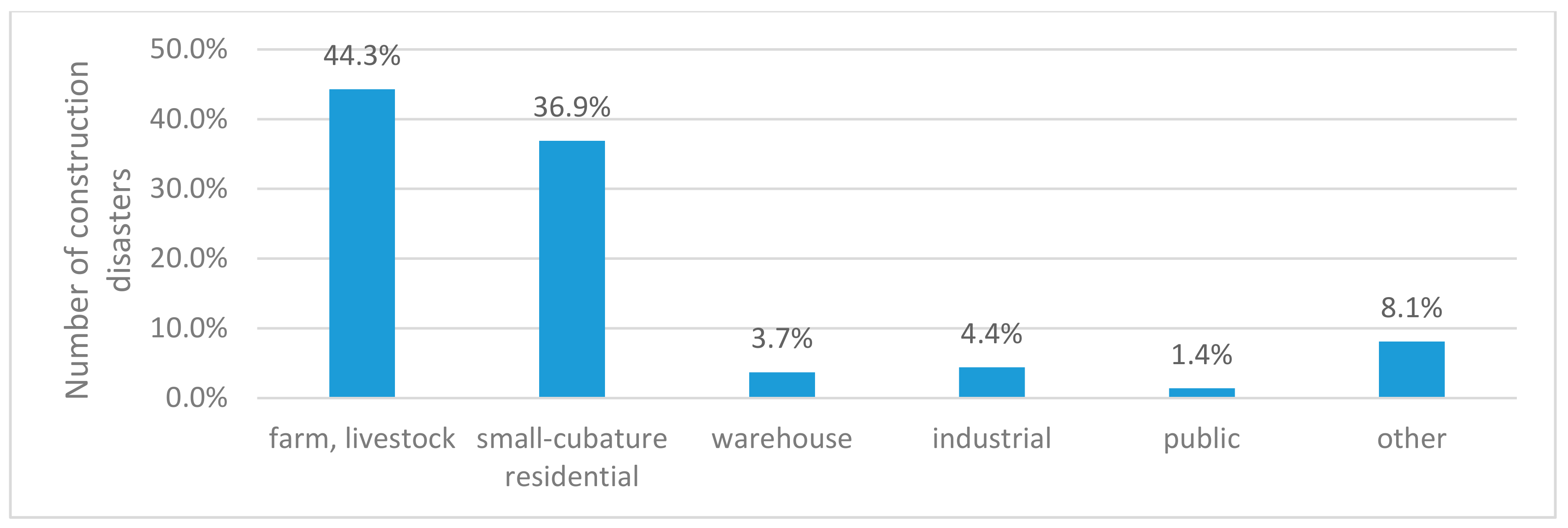
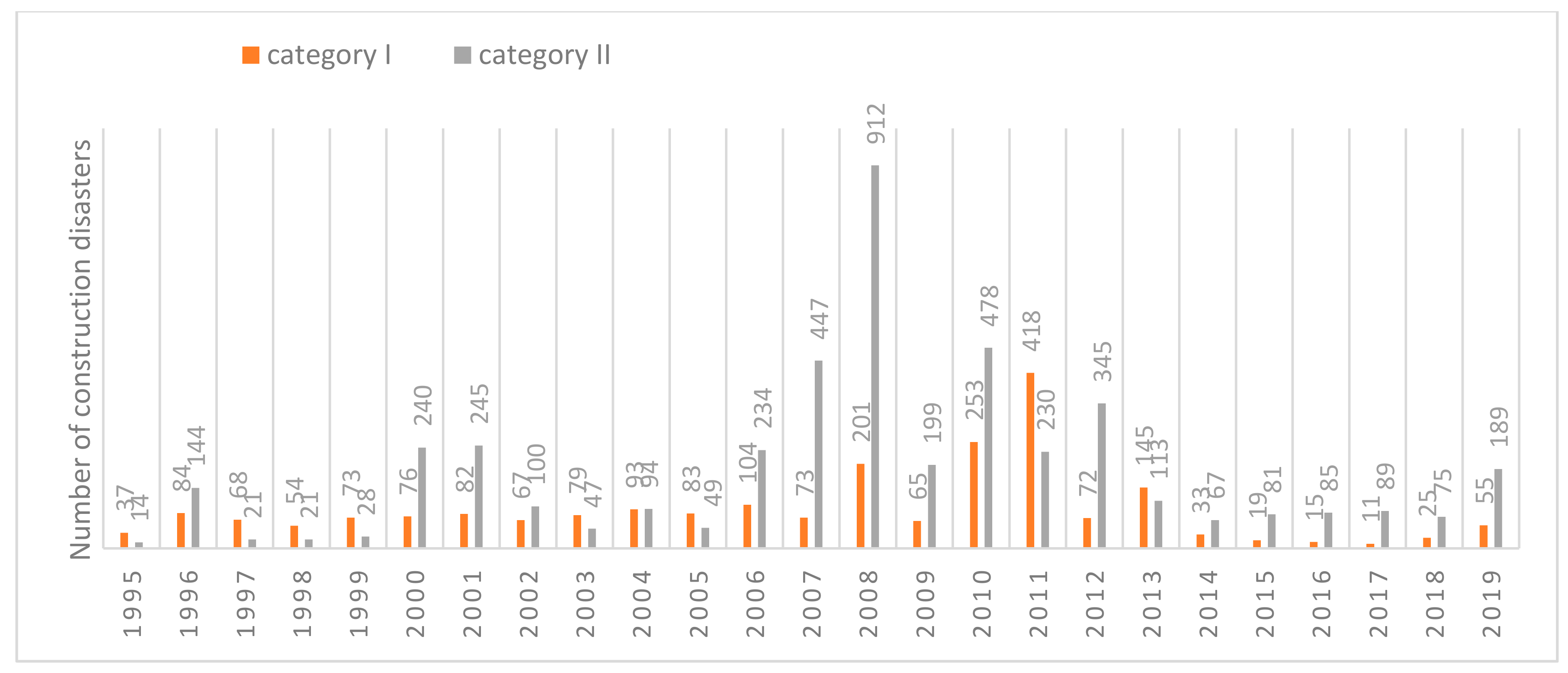
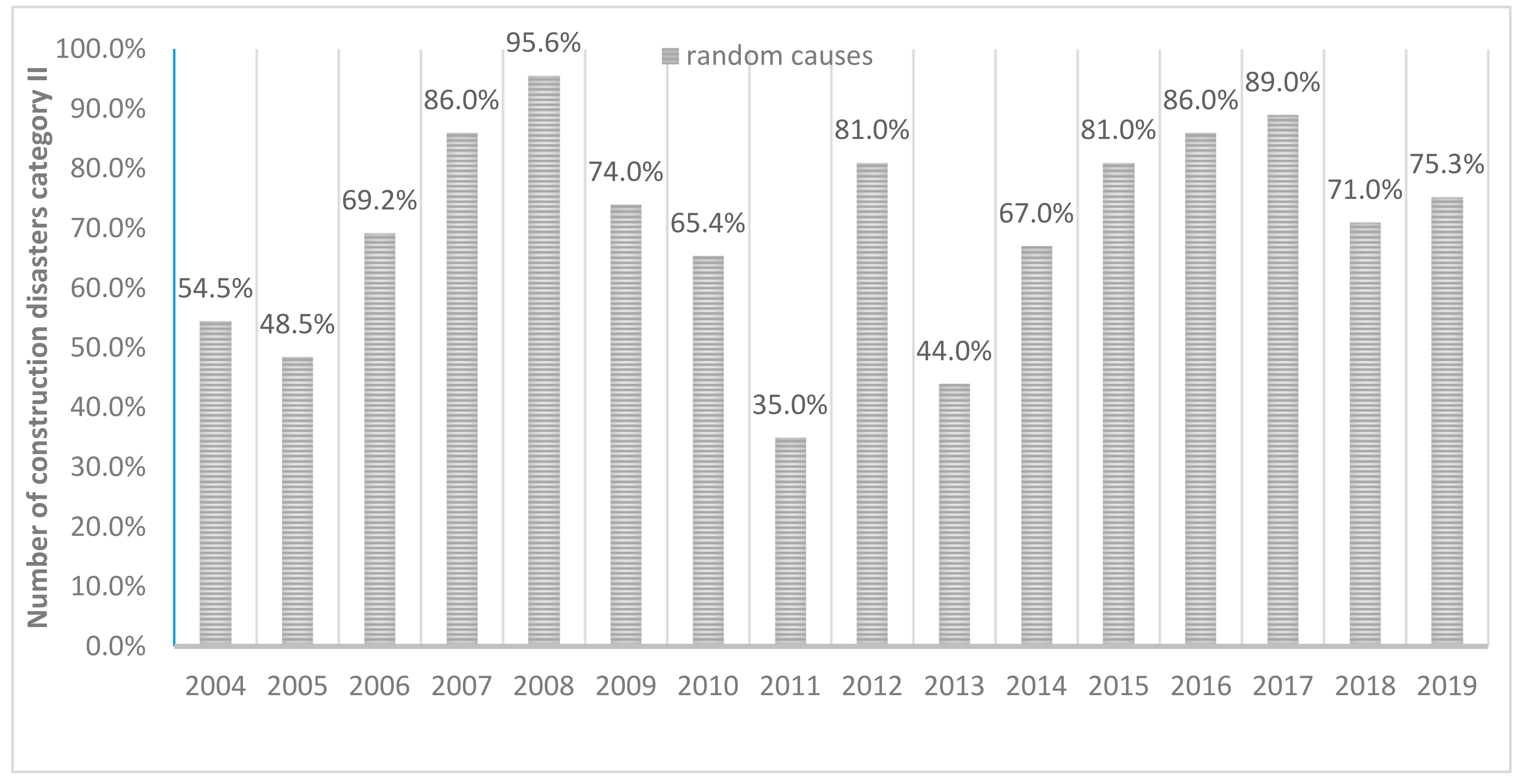

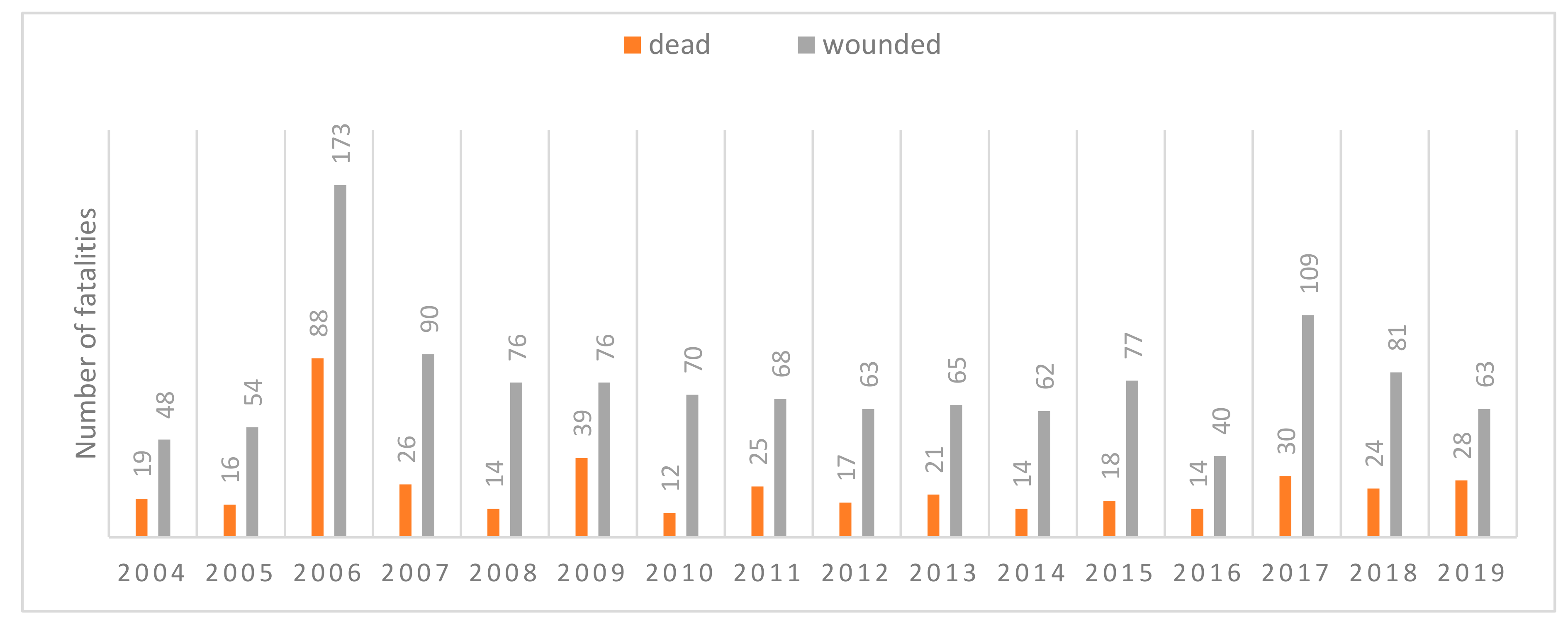

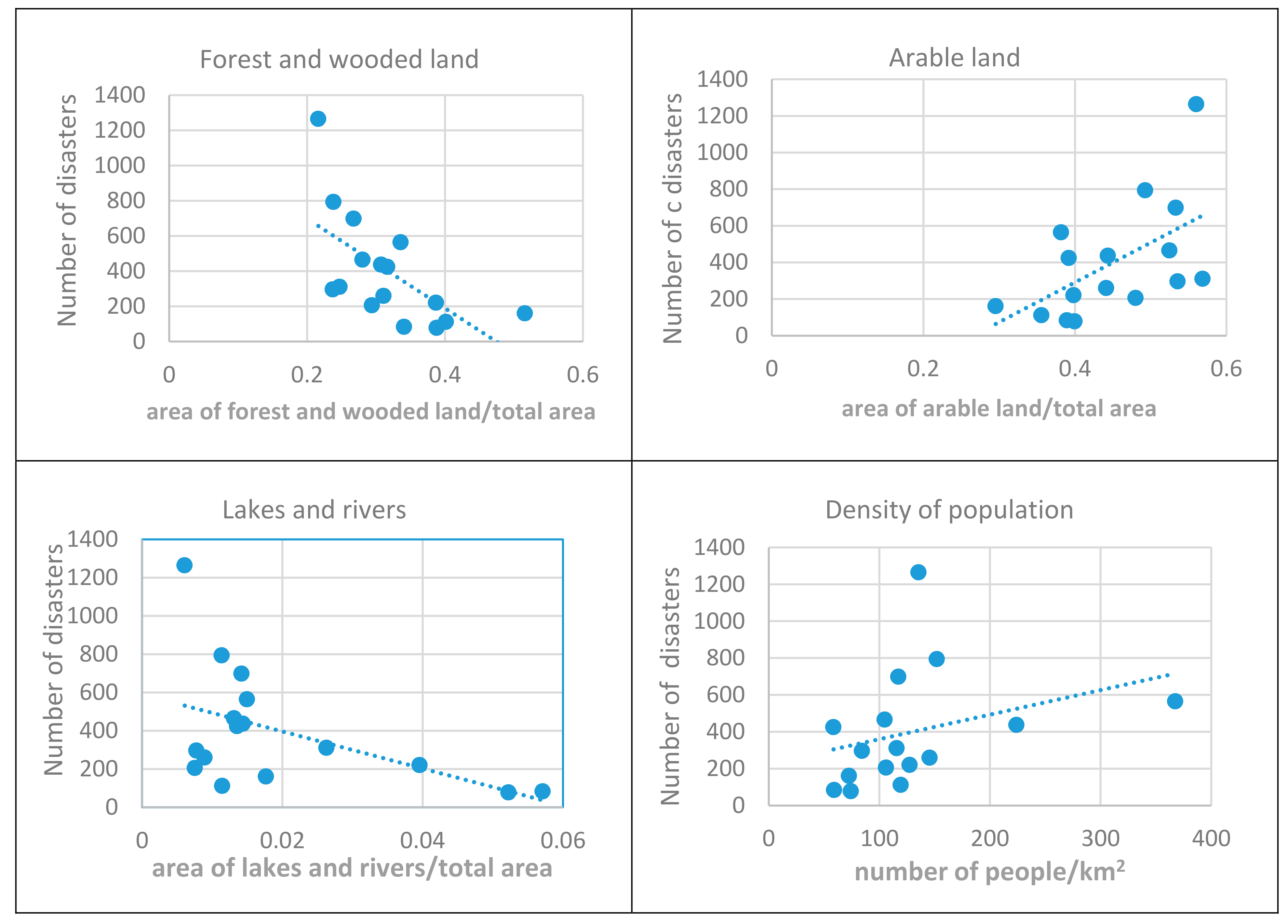
| Accidental Actions | |
|---|---|
| Accidental Actions Global | Accidental Actions Localized |
| abnormal wind load | local wind load |
| abnormal snow load | local snow load |
| external gas explosion | internal gas explosion |
| external fire spread | internal fire spread |
| side impact from a big aircraft | side impact from a small aircraft |
| avalanche | hard landing of a helicopter on the roof |
| flood | impact from a road vehicle or train on the lower part of the building/supporting substructures |
| seismic action | localized failure caused by an unspecified accidental event |
| ice phenomenon on rivers | lightning discharge |
| derailment of a train | collision from a ship |
| Voivodeship | Agricultural land—Permanent Meadows [−] | Forest and Wooded Land [−] | Lakes and Rivers [−] | Industrial Areas [−] | Arable Land [−] | Built-Up and Urbanized Land—Residential Areas [−] | Density of Population [Persons/km2] | Wind (Average Value) [m/s] | Number of Disasters [No] |
|---|---|---|---|---|---|---|---|---|---|
| 1 | 2 | 3 | 4 | 5 | 6 | 7 | 8 | 9 | 10 |
| Lower Silesian | 0.0717 | 0.3109 | 0.0089 | 0.0069 | 0.4413 | 0.0102 | 145.45 | 3.20 | 260 |
| Kuyavian-Pomeranian | 0.0493 | 0.2474 | 0.0263 | 0.0033 | 0.5684 | 0.0087 | 115.62 | 3.40 | 311 |
| Lublin | 0.1023 | 0.2373 | 0.0078 | 0.0015 | 0.5356 | 0.0038 | 84.29 | 3.00 | 297 |
| Lubusz | 0.0739 | 0.5160 | 0.0177 | 0.0020 | 0.2953 | 0.0062 | 72.53 | 3.10 | 161 |
| Łódź | 0.0648 | 0.2162 | 0.0061 | 0.0032 | 0.5602 | 0.0099 | 135.37 | 3.70 | 1265 |
| Lesser Poland | 0.0664 | 0.3075 | 0.0144 | 0.0047 | 0.4435 | 0.0111 | 223.98 | 2.80 | 437 |
| Mazovian | 0.0800 | 0.2384 | 0.0114 | 0.0030 | 0.4927 | 0.0113 | 151.96 | 3.90 | 794 |
| Opole | 0.0772 | 0.2805 | 0.0131 | 0.0051 | 0.5247 | 0.0093 | 104.82 | 2.60 | 466 |
| Subcarpathian | 0.0671 | 0.4014 | 0.0114 | 0.0027 | 0.3558 | 0.0070 | 119.30 | 3.60 | 112 |
| Podlaskie | 0.1041 | 0.3165 | 0.0136 | 0.0012 | 0.3919 | 0.0043 | 58.53 | 2.80 | 425 |
| Pomeranian | 0.0645 | 0.3869 | 0.0396 | 0.0028 | 0.3982 | 0.0097 | 127.44 | 3.90 | 221 |
| Silesian | 0.0753 | 0.3359 | 0.0150 | 0.0169 | 0.3816 | 0.0331 | 367.59 | 3.00 | 565 |
| Świętokrzyskie | 0.0824 | 0.2942 | 0.0075 | 0.0031 | 0.4801 | 0.0060 | 106.02 | 2.80 | 206 |
| Warmian-Masurian | 0.0731 | 0.3406 | 0.0571 | 0.0012 | 0.3893 | 0.0051 | 59.11 | 3.00 | 84 |
| Greater Poland | 0.0714 | 0.2675 | 0.0142 | 0.0028 | 0.5330 | 0.0085 | 117.14 | 3.70 | 699 |
| West Pomeranian | 0.0702 | 0.3881 | 0.0522 | 0.0034 | 0.3995 | 0.0048 | 74.31 | 3.80 | 78 |
| Agricultural Land—Permanent Meadows | Forest and Wooded Land | Lakes and Rivers | Industrial Areas | Arable Land | Built-Up and Urbanized Land—Residential Areas | Density of Population | Wind (Average Value) | Number of Disasters | |
|---|---|---|---|---|---|---|---|---|---|
| Agricultural land—permanent meadows | 1.000 | −0.110 | −0.294 | −0.144 | −0.082 | −0.191 | −0.216 | −0.435 | −0.036 |
| Forest and wooded land | −0.110 | 1.000 | 0.370 | −0.006 | −0.911 | −0.052 | −0.115 | 0.006 | −0.626 |
| Lakes and rivers | −0.294 | 0.370 | 1.000 | −0.173 | −0.334 | −0.178 | −0.273 | 0.241 | −0.491 |
| Industrial areas | −0.144 | −0.006 | −0.173 | 1.000 | −0.117 | 0.952 | 0.903 | −0.176 | 0.164 |
| Arable land | −0.082 | −0.911 | −0.334 | −0.117 | 1.000 | −0.090 | −0.038 | 0.074 | 0.560 |
| Built-up and urbanized land—residential areas | −0.191 | −0.052 | −0.178 | 0.952 | −0.090 | 1.000 | 0.948 | −0.046 | 0.319 |
| Density of population | −0.216 | −0.115 | −0.273 | 0.903 | −0.038 | 0.948 | 1.000 | −0.064 | 0.321 |
| Wind (average value) | −0.435 | 0.006 | 0.241 | −0.176 | 0.074 | −0.046 | −0.064 | 1.000 | 0.238 |
| Catastrophes | −0.036 | −0.626 | −0.491 | 0.164 | 0.560 | 0.319 | 0.321 | 0.238 | 1.000 |
| Correlation coefficient |r| | Importance | Colour | |||||||
| 0–0.3 | poor correlation | white | |||||||
| 0.3–0.5 | moderate correlation | yellow | |||||||
| 0.5–0.7 | strong correlation | orange | |||||||
| 0.7–1 | very strong correlation | red | |||||||
| Date | W | p-Value |
|---|---|---|
| Number of disasters | 0.8632 | 0.02143 |
| Number of disasters (without outlier) | 0.93006 | 0.2735 |
| Arable land | 0.94728 | 0.4479 |
| Forest and wooded land | 0.9256 | 0.2075 |
| Lakes and rivers | 0.7476 | 0.000594 |
| Built-up and urbanized land–residential areas | 0.61907 | 2.46 × 10−5 |
| Density of population | 0.75211 | 0.000674 |
| Pearson | ||||
| Series | r | t | p-Value | Alternative Hypothesis H1 |
| Forest and wooded land/number of disasters | −0.625776 | −3.0018 | 0.9952 | true |
| Arable land/number of disasters | 0.5599582 | 2.5288 | 0.01204 | true |
| Green data/number of disasters | −0.6790475 | −3.4611 | 0.9981 | true |
| Spearman | ||||
| Series | rho | t | p-Value | Alternative Hypothesis H1 |
| Forest and wooded land/number of disasters | −0.7264706 | −3.955 | 0.001024 | true |
| Arable land/number of disasters | 0.5470588 | 2.4453 | 0.0153 | true |
| Green data/number of disasters | −0.7382353 | −4.095 | 0.0007992 | true |
Publisher’s Note: MDPI stays neutral with regard to jurisdictional claims in published maps and institutional affiliations. |
© 2021 by the authors. Licensee MDPI, Basel, Switzerland. This article is an open access article distributed under the terms and conditions of the Creative Commons Attribution (CC BY) license (http://creativecommons.org/licenses/by/4.0/).
Share and Cite
Szymczak-Graczyk, A.; Laks, I.; Ksit, B.; Ratajczak, M. Analysis of the Impact of Omitted Accidental Actions and the Method of Land Use on the Number of Construction Disasters (a Case Study of Poland). Sustainability 2021, 13, 618. https://doi.org/10.3390/su13020618
Szymczak-Graczyk A, Laks I, Ksit B, Ratajczak M. Analysis of the Impact of Omitted Accidental Actions and the Method of Land Use on the Number of Construction Disasters (a Case Study of Poland). Sustainability. 2021; 13(2):618. https://doi.org/10.3390/su13020618
Chicago/Turabian StyleSzymczak-Graczyk, Anna, Ireneusz Laks, Barbara Ksit, and Maria Ratajczak. 2021. "Analysis of the Impact of Omitted Accidental Actions and the Method of Land Use on the Number of Construction Disasters (a Case Study of Poland)" Sustainability 13, no. 2: 618. https://doi.org/10.3390/su13020618





